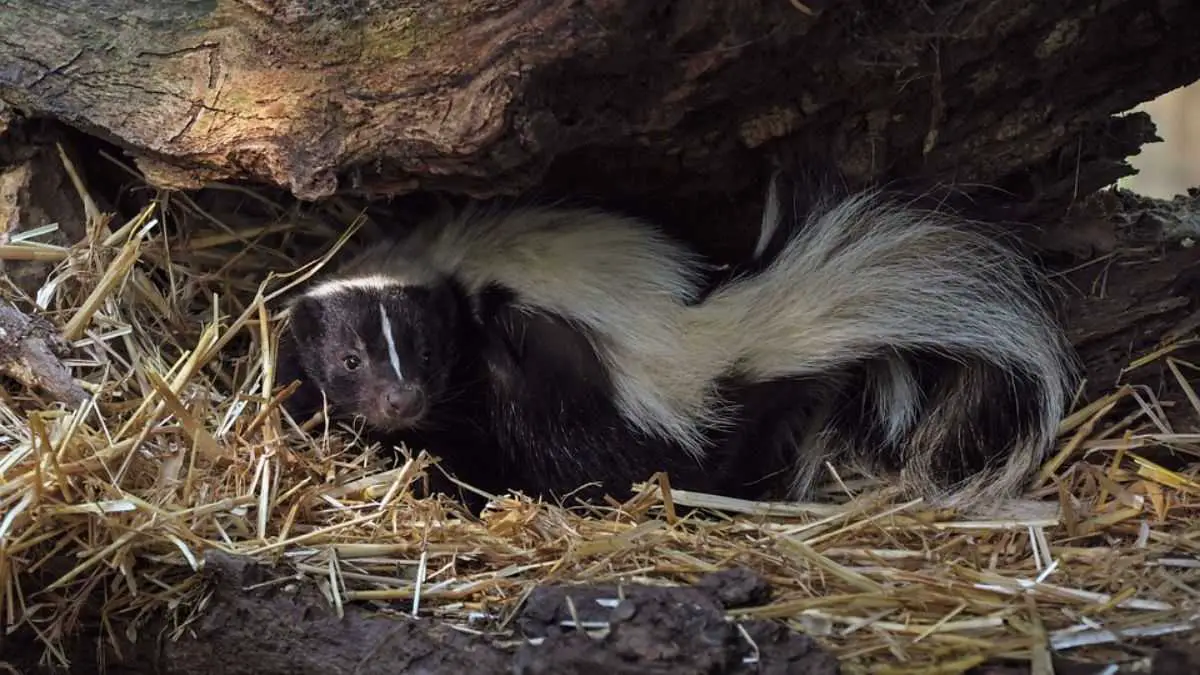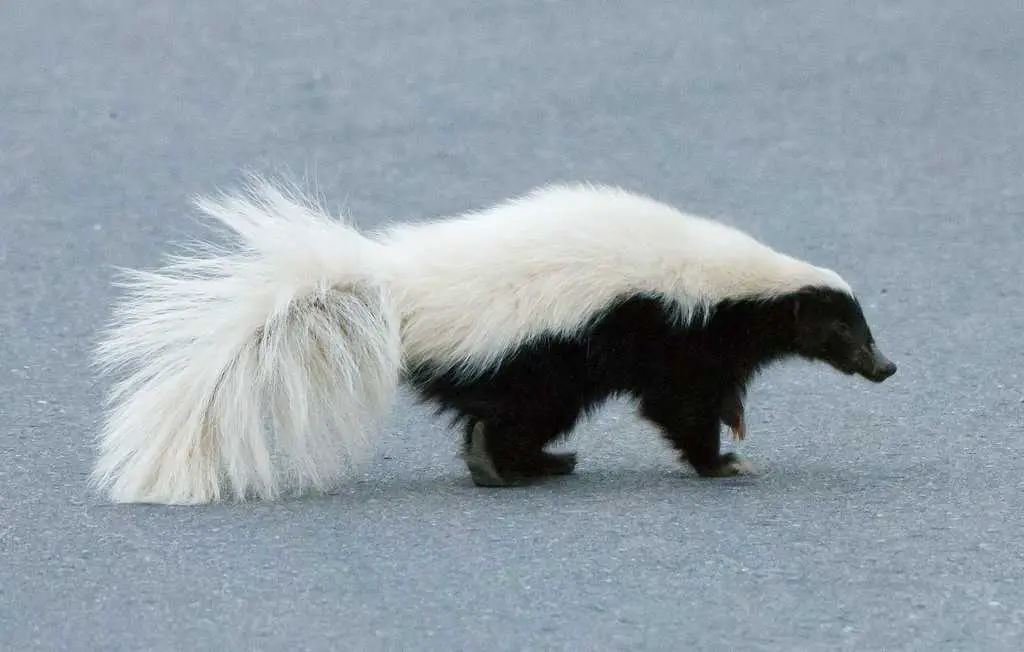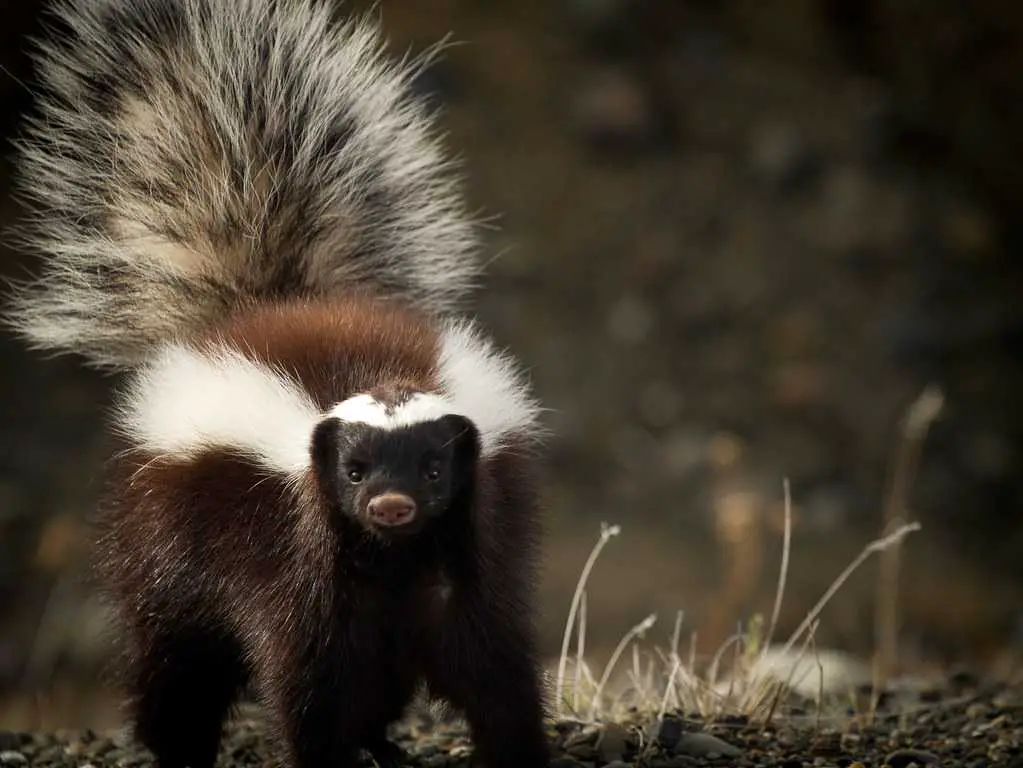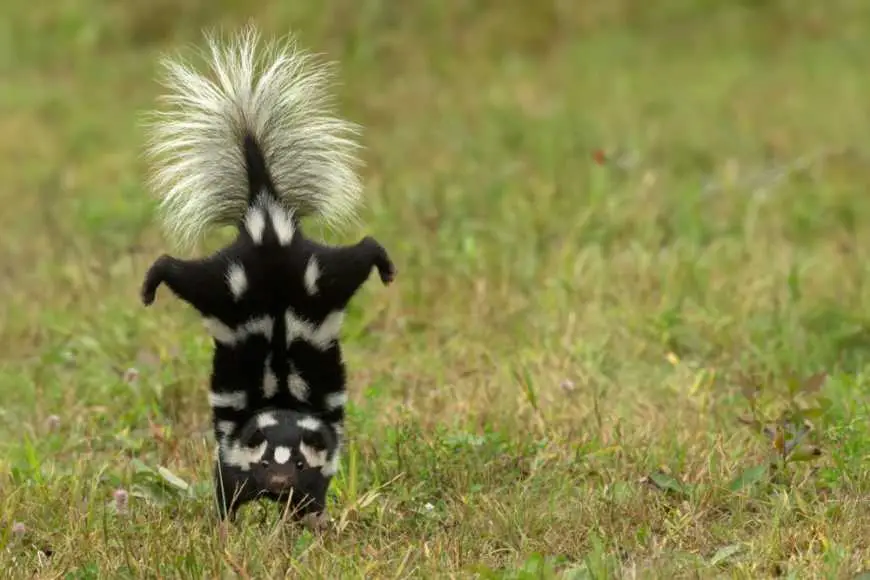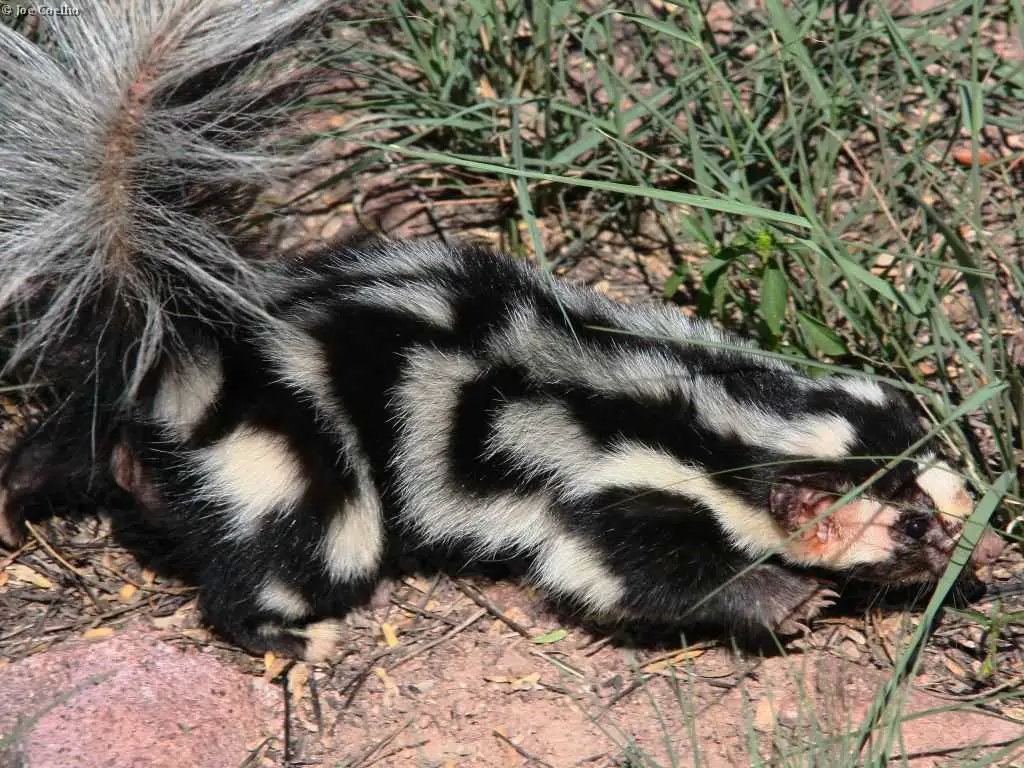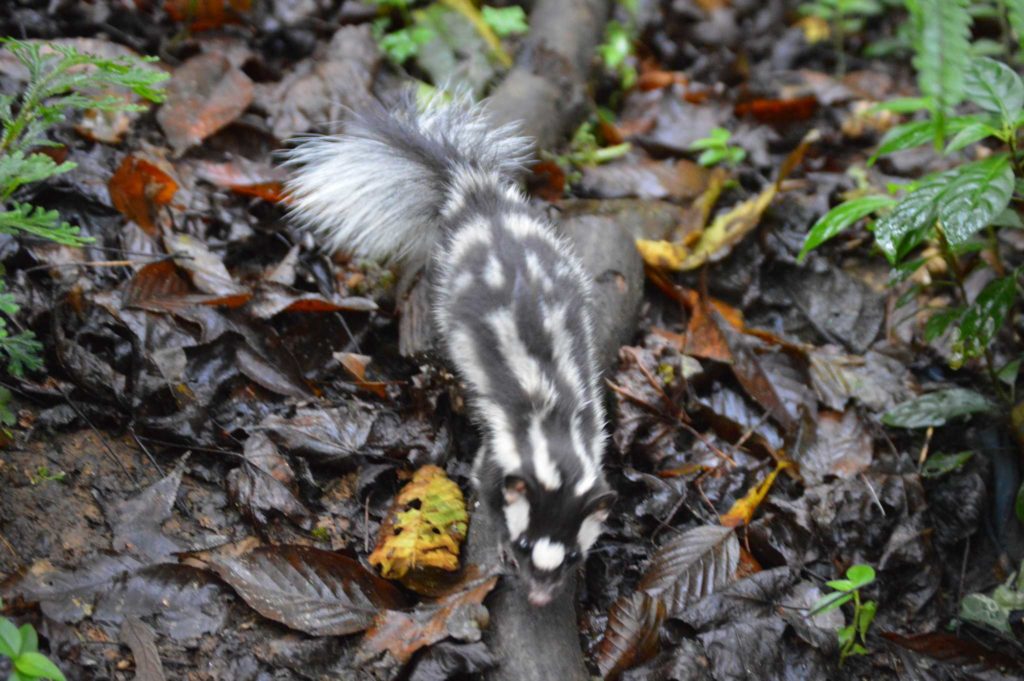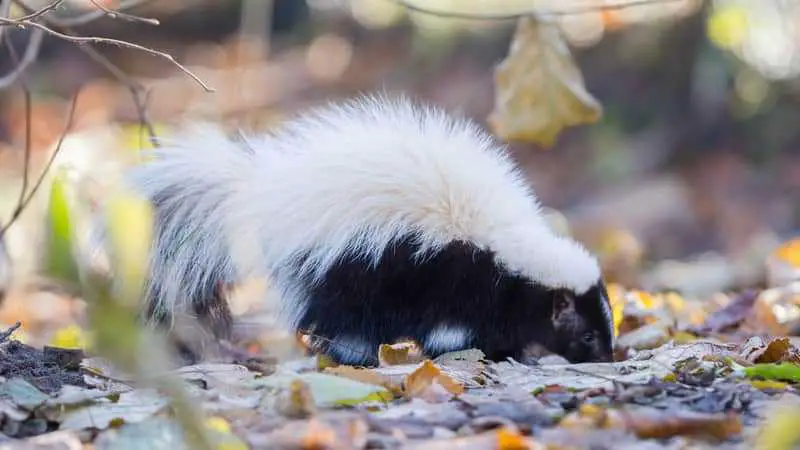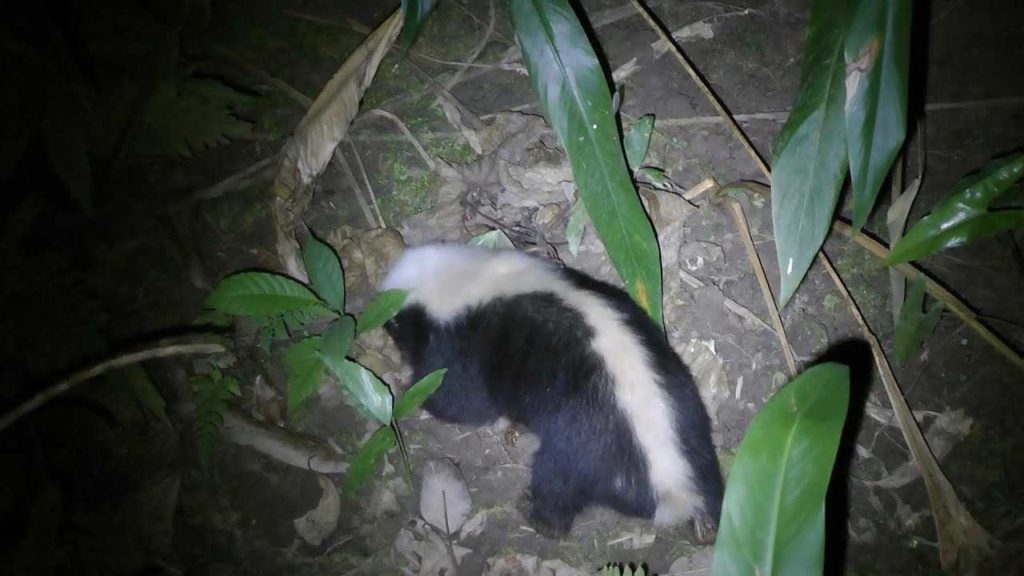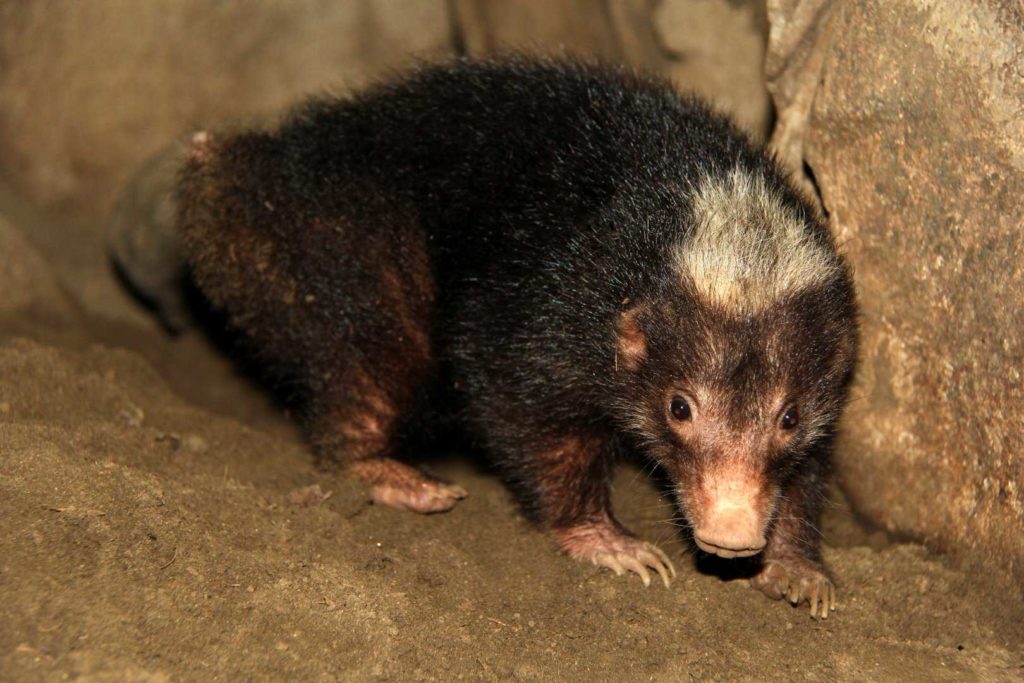Types of skunks: There are 12 species of skunks but there are 5 types of skunks that stand out the most. No matter the species though, they all have the same thing in common, they all stink. Their scientific name, Mephitidae, really means stink. So you know that little critters are the real deal.
Skunk are omnivores and are known to eat anything from insects and larvae, earthworms, grubs, rodents, lizards, salamanders, frogs, snakes, fish, birds, moles, and eggs as well as berries, roots, leaves, grasses, fungi, and nuts. Here are the different skunk varieties.
Contents
Striped skunks
Striped skunks are the most common skunk species in North America. They’re the ones that you most likely see in your backyard. Striped skunks have black and white markings and can live in most terrain throughout North America without a problem.
These animals have a white stripe that runs from its head to its tail which is how they’re identified. Striped skunks are pretty smart. They don’t spray their dens nor do they spray in confined areas. I think they know just how much they stink.
- Scientific name: Mephitis mephitis
- Class: Mammalia
- Order: Carnivora
- Family: Mephitidae
- Rank: Species
Hog-Nosed Types of Skunks
Hog-nosed skunks get their name because they have a broad nose that resembles the nose of a pig. There are 4 different species of hog-nosed skunks:
American Hog-Nosed Skunk
The American hog-nosed skunk (also Western Hog-Nosed Skunk) is a species of hog-nosed skunk native to Central and North America. They are known to grow to lengths of up to 2.7 feet making them one of the largest of their kind.
These are skunk with no stripes and instead, it has a single, broad white coat of fur from the top of the head to the base of the tail, with the tail itself being completely white. However, the underside/lower body of the skunk is black in color. They prefer to live in canyons, streamsides, and rocky terrain.
- Scientific name: Conepatus leuconotus
- Mass: 4.2 lbs (Adult)
- Length: 17 in. (Adult)
- Trophic level: Carnivorous
- Conservation status: Least Concern (Population decreasing)
- Gestation period: 61 days
Molina’s Hog-Nosed Skunk
Would you ever have thought that there was a cute skunk? Molina’s hog-nosed skunk have thin white markings. It generally has black fur and 2 white stripes running from the top of the head down the sides of the body to a mostly white tail. And, of course, a pink, hog-like, fleshy nose
These cute skunks live mainly in mid to southern South America, Chile, Peru, northern Argentina, Bolivia, Paraguay, Uruguay, and southern Brazil. Like other skunks, they prefer to hunt at night.
- Mass: 7.5 lbs (Adult)
- Scientific name: Conepatus chinga
- Conservation status: Least Concern (Population decreasing)
- Rank: Species
- Higher classification: Hog-nosed skunk
Striped Hog-Nosed Skunk
Striped hog-nosed skunks are black in color with a white patch of fur beginning at the back of their neck that spreads out into two white stripes. Their tail is black and white and not as bushy as other species of skunk.
These skunks live in Central and South America (from southern Mexico to northern Peru, and in the extreme east of Brazil). Most of them occupy rocky, sparsely timbered areas.
- Mass: 4.4 lbs (Adult)
- Scientific name: Conepatus semistriatus
- Conservation status: Least Concern
- Trophic level: Omnivorous
- Rank: Species
- Higher classification: Hog-nosed skunk
Humboldt’s Hog-Nosed Skunk
Humboldt’s hog-nosed skunk is also known as the Patagonian hog-nosed skunk because they inhabit the open grassy areas within the Patagonian regions of South Argentina.
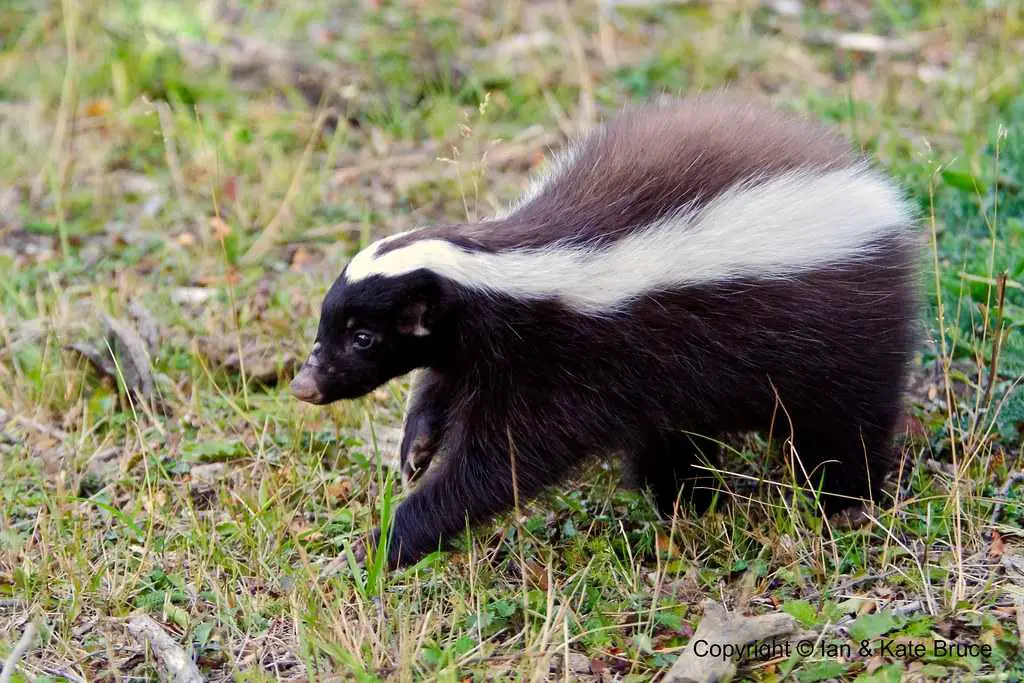
These types of skunks have brownish-red fur with two symmetrical stripes on either side, that extends all the way to the tail. They have the signature pig-like nose that is typical of other hog-nosed skunk species as well as long claws which they use to hunt for food such as ground beetles, grasshoppers, and crickets.
- Scientific name: Conepatus humboldtii
- Mass: 2.4 lbs (Adult)
- Conservation status: Least Concern (Population stable)
- Trophic level: Carnivorous
- Length: 14 in. (Adult) Encyclopedia of Life
- Rank: Species
Spotted Skunk Types
There are 4 species of spotted skunks and they are by far the cutest skunks that you can find in the wild. Although, they still spray you with stink gas if they feel threatened.
These types of skunks prefer insects. So spotted skunks play an important role in insect control. Cute and good for the environment! Let’s have a look at the different species.
Eastern Spotted Skunk
Eastern spotted skunks are a small and slender skunk species that inhabit areas of the eastern United States as well as parts of Canada and Mexico. They have thick black fur that has around 4 to 6 broken, white stripe-like patterns. It’s one of the few skunks with no stripes and long hair.
They are also referred to as tree skunks because they are very good at climbing trees in search of fruits and the occasional snake. If you do run into this cute furball, you’d have plenty of time to react to it. These types of skunks stomp around and perform handstands as a warning before they spray.
- Scientific name: Spilogale putorius
- Trophic level: Omnivorous
- Conservation status: Least Concern (Population decreasing)
- Mass: 1.3 lbs (Adult)
- Gestation period: 33 days
Western Spotted Skunk
As the name suggests, this little skunk inhabits areas in the western parts of North America. Western spotted skunks have bold black and creamy white stripes. There are three longitudinal stripes on each side of the front part of the body, and three vertical stripes on the hind-parts.
One way to tell the difference between the western and eastern spotted skunks is that the western spotted skunk has more visible white coats. These skunks raise their tails, stomp, hiss, charge, scratch, before taking aim to spray foes with a foul-smelling ejection of liquid.
- Scientific name: Spilogale gracilis
- Conservation status: Least Concern (Population decreasing)
- Rank: Species
- Higher classification: Spotted skunks
- Order: Carnivora
- Kingdom: Animalia
Southern Spotted Skunk
Are you starting to notice a pattern with these skunk names? The southern spotted skunk lives in areas of Costa Rica to southern Mexico. These skunks mostly resemble the western spotted skunk. Like most other types of skunks, they are nocturnal hunters and typically feed on small mammals, insects, birds, eggs, grain, and fruit.
- Scientific name: Spilogale angustifrons
- Conservation status: Least Concern (Population stable)
- Rank: Species
Pygmy Spotted Skunk
Nope, there isn’t a northern spotted skunk! Instead, the pygmy spotted skunk is only found in Mexico. They have a black coat with distinctive white markings on its forehead and 2-6 white stripes over its back and sides.
They’re nocturnal creatures and prefer to flee when threatened. However, like all skunks, if things get really tough, the pygmy spotted skunk will spray a foul-smelling liquid when needed.
- Scientific name: Spilogale pygmaea
- Order: Carnivora
- Family: Mephitidae
- Phylum: Chordata
- Class: Mammalia
- Rank: Species
Hooded Skunks
These furry skunks get their name from the white cape-like fur that covers their head and necks. Some are completely black save for a white hood and some white areas on the tail. Others have a single wide, white dorsal stripe. The tails of hooded skunks are longer and their fur is softer than that of the striped skunk.
They are also known as the southern skunk, long-tailed Mexican skunk, or the white-sided skunk. They inhabit areas of the Southwestern United States all the way down to Costa Rica in Central America.
Hooded skunks can live in several habitats, from dry lowlands to boreal forests or plateaus, and many habitats in between. These skunks may be found in high-elevation ponderosa pine forests, deciduous forests, forest edges, riparian zones, rocky canyons, grasslands, pastures, and arid desert lowlands. In Oaxaca, Mexico, where they are the most common skunk species, they prefer grasslands and marshes over scrublands.
http://www.biokids.umich.edu/critters/Mephitis_macroura/
- Scientific name: Mephitis macroura
- Higher classification: Mephitis
- Rank: Species
- Family: Mephitidae
- Kingdom: Animalia
- Phylum: Chordata
Stink Badgers
There are two species of stink badgers which, despite the name, are actually skunk. The Sunda stink badger and Palawan stink badger.
Sunda Stink Badger
The Sunda stink badger, also called the Javan stink badger, teledu, Malay stink badger, Malay badger, Indonesian stink badger, and Sunda skunk is a mammal endemic to Indonesia and Malaysia.
Sunda stink badgers have coarse fur that is either black or very dark brown over most of its body. There is a white stripe running from the top of its head to the tail. Their tails are short and covered in white fur.
These types of skunks prefer to play dead when threatened. However, if that fails, they resort to deploying a stream of foul-smelling liquid at foes.
- Scientific name: Mydaus javanensis
- Mass: 5.5 lbs (Adult)
- Conservation status: Least Concern
- Trophic level: Omnivorous
- Length: 17 in. (Adult)
- Rank: Species
Palawan Stink Badger
The Palawan stink badger, also known as the pantot, is named for its resemblance to badgers, its powerful foul odor, and the largest island to which it is indigenous Palawan.
These species have a short tail and pointed snout. Its fur is dark brown with a light yellow patch on the top of its head that fades down to the shoulders into a stripe. Unlike the Sunda stink badger, Palawan stink badger will attack and spray foes with its foul-smelling liquid at the first chance it gets.
- Scientific name: Mydaus marchei
- Mass: 5.5 lbs (Adult)
- Conservation status: Least
- Length: 15 in. (Adult)
- Higher classification: Stink badger
- Rank: Species
References:
- How to Identify Different Types of Skunks | Terminix – https://www.terminix.com/blog/education/what-type-of-skunk-is-that/
- The Colors of Skunks – Sciencing – https://sciencing.com/colors-skunks-8686827.html
- How many species of skunks are there? – https://www.britannica.com/animal/skunk
Are There Brown Skunks?
Although the most common fur color is black and white, some skunks are brown or grey and a few are cream-colored. All skunks are striped, even from birth.
What Is A Female Skunk Called?
Male skunk is called buck, female – doe, and baby skunk – kit.
How Many Times Can A Skunk Spray?
Skunks are known for their discharge, an obnoxious odor when provoked. This is released primarily in self-defense. A skunk can release a spray of oily liquid as far as 10-15 feet and spray up to six times in succession.
